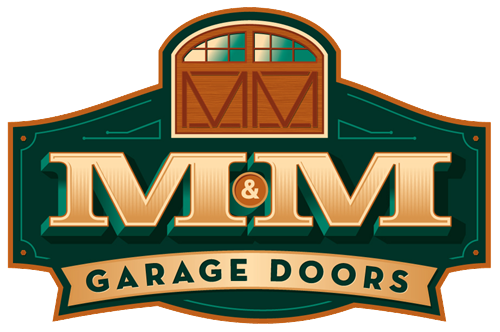From garage door types to garage door cleaning safety considerations, we are here to give you insight into the most popular topics regarding the most significant component of your home besides your roof. We hope you find this guide helpful as you navigate the garage door replacement process.
Most Popular Garage Door Types
There are six top kinds of garage doors.
1. Sectional Garage Doors
Sectional garage doors are the most popular type in this country, featuring panel sections that have been connected by strong hinges. When the door opens and closes, the wheels along the panel edges roll within a vertical track at the sides. Those hinges continue to travel over the track’s curved portion so the door can rest parallel to the ceiling when it’s opened – or when it’s closed, lined up with the walls.
These doors are typically made out of steel. They’re low in maintenance, and you can customize them in terms of texture, color, hardware, and window inserts.
2. Roll Up Garage Doors
These are more common in commercial buildings than in residential homes, but this no-frills design is good for structures that are limited on ceiling space. This style comprises steel slat sections that roll around a drum found above the door’s opening. Designed to handle heavy usage, the enclosed springs can prevent rust and freezing.
3. Side Hinged Garage Doors
This old-fashioned design features doors that can swing open and closed via a hinged frame on either opening side. Just like large barn doors, side hinged doors are usually made out of wood, but you could also opt for commercial-grade galvanized steel if you wanted. Choose this style if you have a garage with obstructions or with limited headroom. They come in pre-hung frames of steel, or you could opt to buy them to fit them into your existing openings, automated with conversion arms.
4. Tilt-Up/Up and Over Canopy Garage Doors
Similar to its side-hinged sister, these garage doors are made of one solid piece rather than sections. There is a pivoting hinge mechanism so they can tilt up inside the garage. The canopy-style door pushes outward beyond the home when opened, sitting parallel to the ceiling.
5. Tilt-Up/Up and Over Retractable Garage Doors
Just like the tilt-up canopy design, this type lifts up and inside the garage as it is suspended independently from the frame without protruding past the house’s exterior. You’ll need a lot of space to accommodate these doors than you do for canopy garage doors.
6. Slide to the Side Garage Doors
Just like they sound, these doors bend to one side of your garage and come to rest parallel to the wall. Interestingly, this was the first kind of garage door to ever exist, originally meant for garages with limited space and headroom. Operating via flexible lower trolleys, they work well with slight slopes in the ceilings or floors. You don’t need balancing springs with this type but they feature retractable, built-in motors that don’t require an operator to be mounted on the ceiling.
If you need help choosing the right garage door for your home, don’t hesitate to call M&M Garage Doors at (586) 610-5434.
Garage Door Checklist: Safety, Function, Material
While the type and aesthetics of your new garage door are important, you also want to make sure you’re installing a door that scores well in functionality, operation, and safety. Here are some factors to consider:
- Safety: The door you choose should have the latest safety advancements, from reversal functions to pinch-resistant features. Because the garage door is the largest moving piece of equipment in your house, it has the power to maim or kill. This is why safety is the top priority.
- Material: Choose from wood, steel, aluminum, or vinyl. The one you select will vary with your budget, personal preference, and available space.
- Maintenance: The upkeep requirements are essential when considering which door to choose. For instance, while wood is classic and beautiful, you need to paint or stain it regularly, so it doesn’t chip or rot. Steel doors are durable, and all they need is occasional cleaning. Vinyl doors are long-lasting, won’t rust, and do not require paint or stain. Similarly, aluminum doors are low in maintenance as well.
- Springs: The counterbalance spring system is responsible for opening and closing your door. While the opener provides the first push, the springs handle the bulk of the work. To that end, the spring mechanism must be sturdy and robust.
- Insulation: The level of insulation your garage doors have will determine what your energy costs will be. Look for a higher R-Value, which cuts down on outside noises while ensuring more stable temperatures inside.
- Service Quality: Quality of installation is critical. Sub-par installation done by unqualified professionals can translate to much higher costs in the long run when you consider energy inefficiency, dangerous safety risks, and the higher propensity for repairs and premature replacement.
- Warranty: It’s vital to protect your investment. After all, a new garage door is a significant expense. Be on the lookout for industry-leading warranties on cracking, splitting, and rusting.
Now that you know what to look for in a new garage door, it’s time to start looking at options. Please browse our website today to see the many styles we offer to match your residential home.
We hope you found this guide helpful in choosing or maintaining your garage door. Look out for Part Two next week!
Contact M&M Garage Doors
It can be daunting settling on the right garage door in Metro Detroit. Our experts can help guide you through every step, from design to installation. To learn more, to schedule a consultation, or to get a quote, call M&M Garage Doors today at (586) 610-5434.





